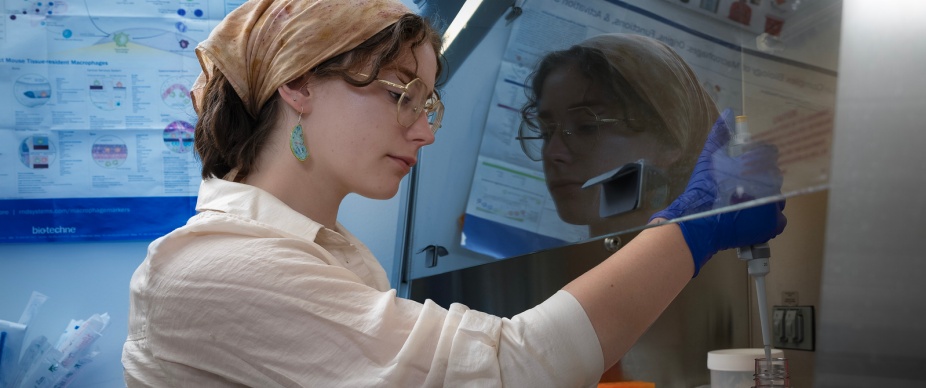BMS 498: Undergraduate Research in Biomedical Sciences

BMS 498 is an exciting opportunity to earn credit toward your major while actively engaging in biomedical research. Working closely with a faculty research mentor, you will help shape your experience by deciding together on your time commitment, research activities, and project goals. Along the way, you’ll strengthen your communication skills through presentations and written work, culminating in a final report summarizing your accomplishments.
Once you are an approved Biomedical Sciences major, you may apply to enroll in BMS 498. To get started, you will need to identify a research opportunity and share your resume with the faculty mentor or sponsoring agency. In some cases, you may also meet with your prospective mentor for an interview. BMS 498 may be taken for 1–4 credits (with a commitment of 3 hours per week per credit), and while you may repeat the course for credit, only one enrollment of up to 3 credits can count toward an advanced elective in the major.
This course is designed to give you authentic research experience, meaningful mentorship, and a chance to explore your scientific interests in depth.
Jump to:
Before the Semester
- Find a research opportunity and make appropriate arrangements for the experience in consultations with the mentor.
- Submit a signed BMS 498 contract to the program director before the drop/add deadlines.
Throughout the Semester
- Meet the time requirement based on the number of credits.
- Keep a timesheet with specific dates and times worked, along with a running total for the semester.
- Meet with your mentor mid-semester to ensure you are on track.
End of the Semester
- Request that your site supervisor complete an evaluation form to determine your grade.
- Submit a final 2-3 page report to the Program Director by the last day of classes, along with the time sheet.
The best place to start looking for a research opportunity is the Center for Undergraduate Research & Creative Activities (CURCA) website. They have a database of all the active research that is taking place on campus.
The research mentor is the primary professional guiding the student’s research experience. Typically, a faculty member or research professional (e.g., MD, PhD, PA), the research mentor works closely with the student, providing direction, support, and oversight. The mentor defines the scope of the project, outlines expectations and responsibilities, and clarifies any limitations of the experience. In addition to supervising day-to-day activities, the mentor evaluates the student’s performance and assigns the final grade.
The Program Director is the faculty member who oversees force registration into the course once the contract is signed, reviews the time sheet and reflection paper, and sends and collects the evaluation from the site supervisor regarding assignment of a final grade.
The time sheet is a record of participation in the research. It should list the dates and time spent at the research site. Date each journal entry and indicate the number of hours spent on site. A note in the margin might read “9/1/25: 2 p.m. – 5 p.m. (3 hours, 15 hours total).” This example refers to the 3 hours spent on site on 9/1/25 and shows a running total of 15 hours to date. Some mentors provide pre-formatted time sheets.
The final 2-3 page report provides students with an opportunity to reflect on their research. It should summarize how well the objectives that were established at the beginning were met by the actual experience. The final report can include references to specific learning experiences, successes and failures, new insights, positive and negative aspects of the research. It should be typed and double-spaced.
| Credits Earned | Total Time Commitment | Typical Schedule |
|---|---|---|
| 1 | 45 hours | 3 hours/week for 15 weeks |
| 2 | 90 hours | 6 hours/week for 15 weeks |
| 3 | 135 hours | 9 hours/week for 15 weeks |
| 4 | 180 hours | 12 hours/week for 15 weeks |
The evaluation is designed to check on a student’s performance and used to help determine the grade.
The grade is based on the recommendation from the site supervisor. You will be given a grade of A-F.
- Find a mentor and make arrangements for your research experience
- Download or print the Application on page 2
- Complete the Application
- Request a signature from your research mentor
- Submit the application for BMS 498 approval
- If approved, you will be enrolled in BMS 498 and notified accordingly
- Ask Supervisor to complete the Evaluation form and submit online. Don't wait until the last minute to do this!
- Write Final Report: The final 2-3 page report provides students with an opportunity to reflect on their research. It should summarize how well the objectives that were established at the beginning were met by the actual experience. The final report can include references to specific learning experiences, successes and failures, new insights, positive and negative aspects of the research. It should be typed and double-spaced.
- Submit Report by the last day of classes for the semester you are registered for.